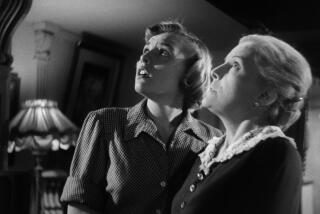3 of Hollywood’s Best Silents at Bing Theater
- Share via
“Restorations, Rarities & Requests” continues at the Los Angeles County Museum of Art’s Bing Theater today and Saturday with three glorious Hollywood silents. The 1926 “Ben-Hur,” which will be shown with its tinted Technicolor sequences and with organist Gaylord Carter performing the original score, screens today at 1 p.m. and again at 8 p.m. Douglas Fairbanks’ swashbuckling “The Black Pirate” (1925) will be shown at 1 p.m. and 8 p.m. on Saturday, and Rudolph Valentino’s final film, “The Son of the Sheik” (1926), follows “The Black Pirate” at 2:20 and 9:20.
After more than 60 years, “Ben-Hur” remains an awesome and moving religious spectacle. Years in the making, it is at once intimate and immense, telling of the travails of a young Jerusalem nobleman, Ben-Hur (Ramon Novarro), under oppressive Roman rule, while in the background the story of Christ (whose face is never seen) unfolds.
Adapted from Gen. Lew Wallace’s 1880 novel, “Ben-Hur” is no more subtle or complex than an old Classics Comics book. Yet, through Fred Niblo’s astute direction, it attains the visual eloquence of a mime play. Along with a genuine aura of spirituality, it boasts a justly famous chariot race, a splendid sea battle and stupendous sets and costumes.
“The Black Pirate,” which Douglas Fairbanks Sr. wrote for himself, is the prototypical pirate picture. It has a villain of the deepest dye, stirring battles at sea, a high-born lady in distress (beauteous Billie Dove) and, best of all for Fairbanks fans, a hero who performs feats of daring with incomparable athletic grace.
As stylish as it is elementary, the film shows off Fairbanks’ gift for spectacular acrobatics, culminating in a slide down a ship’s mainsail--while slicing it with a knife.
Children are as likely to be enchanted with “The Black Pirate,” which the Museum of Modern Art considers the finest achievement of early two-strip Technicolor, as their parents or grandparents were. So simple a tale is it that adults may find themselves feasting more on the remarkable settings (by Karl Oscar Borg) and costumes (by Dwight Franklin) than on the story line. “The Black Pirate” boasts several magnificent vessels, including a galleon of baroque splendor. Incredibly rich in detail, the vessel has the look of authenticity.
Under Albert Parker’s blithe direction, the film moves rapidly. Fairbanks is thoroughly engaging, Dove is lovely and Donald Crisp is a delight as a hearty, one-armed old salt who turns good guy in a pinch. As for the Technicolor--Harry Sharp was the cameraman--it’s almost sepia and gives the film a rich, burnished glow.
Superior artistically to “The Sheik” (1921), which established Valentino as the screen’s greatest Latin lover, “The Son of the Sheik,” which the redoubtable Frances Marion adapted from the E. M. Hull novel, is a heady, flamboyant tale of desert passion, easily derided and spoofed today but nonetheless full of vigor and dash, thanks to George Fitzmaurice’s spirited direction.
However, more than the original did, the film unfortunately suggests strongly the possibility of a man taking a woman forcibly--and her loving it. As a period piece the picture is fun but looks bad in the light of women’s liberation.
Anyway, we find Valentino beguiled by a pretty dancing girl (Vilma Banky) with whom he has oasis trysts, whereas his father, the old sheik (also played by Valentino) wants to marry off his son to a cousin of his English wife (Agnes Ayres).
In this pop entertainment from a past era, Valentino remains the eternal symbol of exotic glamour and romance--even if Gloria Steinem would be unlikely to approve. Information: (213) 857-6010.
More to Read
The biggest entertainment stories
Get our big stories about Hollywood, film, television, music, arts, culture and more right in your inbox as soon as they publish.
You may occasionally receive promotional content from the Los Angeles Times.










